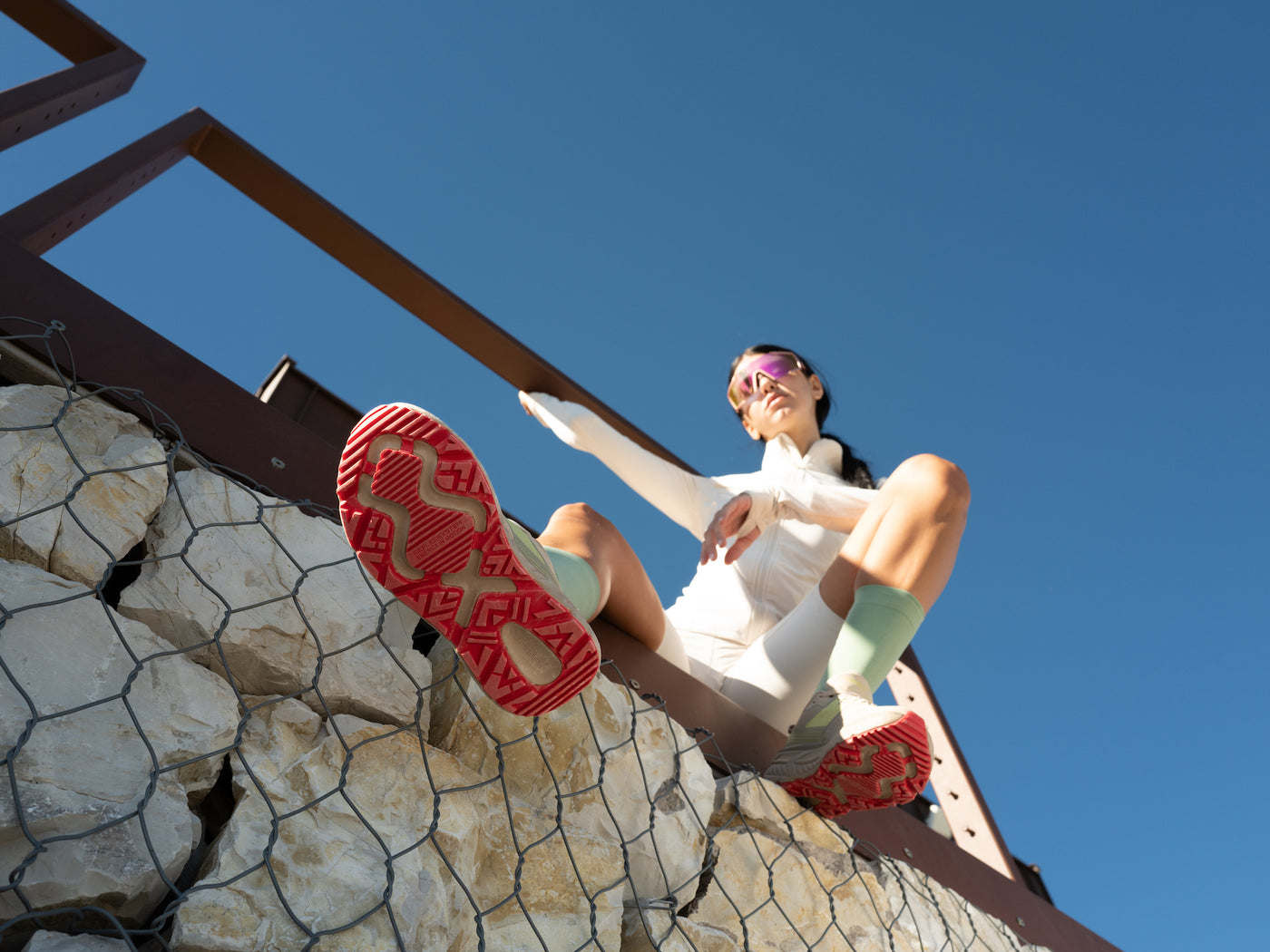
FESSURA HIKING GUIDE
Hiking: what it is
Hiking, from the English 'to hike' or 'to walk', is an outdoor activity that consists of a short excursion, usually a day, on indicated trails with a difficulty that varies from the tourist to the expert. Because of this, it is an activity suitable for everyone; everyone can choose
the route best suited to their preparation: more challenging trails with exposed sections for the more experienced or more leisurely routes for beginners. Being suitable for everyone, hiking is also a way to spend a day together in the mountains.
Are you an outdoor enthusiast? Then you are in the right place to find out more about hiking!

FESSURA HIKING GUIDE
What to wear?
Wear comfortable, movement-friendly clothes;
■ Favour bright colours to be more visible (a reflective jacket should also be worn, especially in the darker hours);
■ Use the 'layering' technique to dress yourself, i.e. several layers of clothing on top of each other, so that you can easily shed one garment in case of high temperatures or reach your ideal body temperature in cold weather;
■ Choose fanny packs or backpacks suitable for walking, to promote correct posture.

FESSURA HIKING GUIDE
• What to bring on a hike
In order to be best prepared and fully enjoy the hike, it is important to know beforehand what you will need. A small backpack (20-25 litres) that is comfortable, breathable and padded on the back will be indispensable to put everything you need:
- water to avoid becoming dehydrated;
- food to regain all the energy lost during the walk;
- sunscreen to protect you from the sun, which can be stronger at high altitudes;
- hat and gloves to prevent drafts and sudden cold;
- rubbish bag to keep the environment clean;
- spare jersey to change once you reach your destination, preventing perspiration from building up on your body;
- snowshoes to support you throughout the day and make your legs less fatigued.

FESSURA HIKING GUIDE
How to manage strength during a hike
Mountains are characterised by irregular terrain with varying conditions and gradients that require good muscular endurance and strength, so it is essential to be prepared to manage one's strength during a hike. First of all, it is advisable to hike regularly, starting with easier trails and increasing in difficulty, in order to adapt your body to the activity and develop your own endurance. In this regard, it is necessary to focus on both cardiorespiratory endurance for adequate oxygen supply and muscular strength to achieve stability.
During the hike, it is important to be able to listen to your body in order to regulate the effort. If there is excessive fatigue, muscle pain or shortness of breath, it is best to take a break to restore your balance.
Below are the three steps for organising a hike:
■ WARM-UP: Before starting the walk, it is important to perform a warm-up to prepare our body for the physical activity. Walking is an activity that involves our entire body; therefore, a warm-up with exercises for all the major muscle groups, from the head down to the feet, is recommended.
■ CENTRAL PHASE: This consists of the actual walking phase and the duration varies according to each individual's physical fitness. Try to maintain a moderate and constant pace throughout this phase.
■ DEFATICATION: After finishing the middle phase, gradually slow down your speed before
stopping walking, followed by some stretching exercises. This phase serves our organism to move gradually from a phase of physical exertion to a state of rest.

FESSURA HIKING GUIDE
How to feed during a hike?
During the hike, our body expels liquids and energy that it needs to replenish. This is why it is important to carry water and food supplies that are digestible and rich in sugar and nutrients, such as energy bars, dried and dehydrated fruit, dark chocolate and dry biscuits.
It is essential to learn to manage hunger and thirst during the walk; therefore take frequent stops to regain energy. For lunch it is usually recommended to take carbohydrates such as a classic sandwich with sliced meat and cheese.

FESSURA HIKING GUIDE
THE SHOE
The activity of walking, especially for people with poorly trained, untoned muscles or incorrect postural vices, can cause strain on the musculoskeletal system, especially on the knees and spine, which in the long term can cause pain or injury. However, there is an easy way to counteract this: use the right footwear! The most important piece of clothing for the
walker is definitely the shoe, which should be comfortable, light and sturdy, adapted to the type of foot support of each individual.
FAQ
- Hiking backpack with water and food.
- Suitable clothing and first aid kit.
- Map, compass, torch.
- Multi-purpose tools and sunscreen.
- Mobile phone, identity card and thermal blanket.
Yes, hiking clothing should be breathable, light and suitable for the weather conditions. It is advisable to wear thermal layers, a windproof or rainproof jacket, durable trousers, hiking socks and sturdy shoes with soles suitable for the terrain. A hat to protect from the sun and light gloves can be useful.
It is important to avoid cotton clothing that retains moisture and prefer synthetic or technical materials that dry quickly.
For trails that are not too technical, the best footwear is low trail/trekking shoes or lightweight boots with a non-slip sole and high cushioning. Make sure they have good grip and ankle support. Shoes should be breathable and comfortable, with good foot protection. Make sure the footwear fits your foot to avoid blisters and discomfort while walking.
During a trekking walk, it is important to avoid overloading your backpack, as too much weight can cause fatigue and stress on your joints. Furthermore, it is essential to wear appropriate footwear to prevent blisters and foot injuries. Another common mistake is neglecting hydration: drinking water regularly helps maintain energy and concentration. Also avoid underestimating the weather conditions and not wearing clothing that is suitable for changing climatic conditions. Finally, do not neglect route planning and orientation, to avoid getting lost and dangerous situations.
The main advantages of a trekking pole include extra support for the joints, especially during steep descents, reduced strain on the leg muscles, better balance and stability on uneven terrain, the possibility to test water depth or ground stability, and the ability to use them to pitch tents or build improvised shelters.
Walking on roads offers an even and predictable surface, suitable for regular footsteps. On trails, you face terrain variations and obstacles such as roots or rocks may present themselves, requiring more attention and stability. In the mountains, the terrain is more challenging, with steeper slopes, unstable ground and possible sudden changes in weather, requiring greater physical and mental preparation, as well as specific navigation and survival skills.
To tackle steep climbs in trail or trekking, it is advisable to keep an even stride, distribute your weight evenly, use your arms to help propel you, breathe deeply and take frequent breaks to avoid fatigue. For steep descents, it is important to maintain a low centre of gravity, bend your knees slightly to absorb shocks, use trekking poles to balance your weight, maintain an upright posture and focus on the stability of the terrain.
It is essential to carry a reliable light source and a power bank, to dress appropriately for the weather conditions, to communicate the route and planned time to someone, to pay special attention to changes in terrain and trail conditions, and to proceed with caution, paying attention to dangers such as precipices, obstacles or wild animals.
If you get hurt during a hike, find a safe place to rest immediately, assess the severity of the injury and try to provide the necessary treatment with the first aid kit. If you get lost, try to stay calm, try to find your way back to the trail by following any signs or landmarks, and if you can't do this, stay where you are to avoid straying further. Activate your emergency device if you have one, and try to signal your location with acoustic or visual signals to attract the attention of helpers.
Joining walking or hiking groups offers numerous benefits, including sharing experiences and knowledge, additional safety in case of emergency or loss, the opportunity to explore new routes in company, mutual motivation to achieve goals, and the chance to develop new friendships and social ties based on a love of outdoor activity.
Yes, many trails allow owners to take their dogs with them on hikes. However, it is important to check the specific rules of the trail and observe the rules of behaviour. Make sure your dog is trained, is sociable with other hikers and is able to cope with the trail conditions. Carry extra water and a bowl for your dog and always keep your dog on a leash when required.
In the event of meeting with wild animals during a trail or trek, it is essential to remain calm and not approach them. Avoid making any sudden movements or noise and keep a safe distance. Do not feed wild animals and avoid blocking their escape route. If the animal approaches, move away slowly and without turning your back on it.



